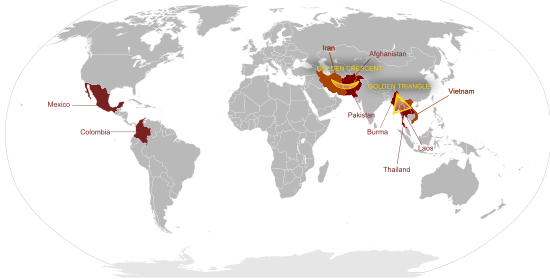
Opium production in Myanmar has historically been a major contributor to the country's gross domestic product (GDP). Myanmar is the world's largest producer of opium, producing some 25% of the world's opium, and forms part of the Golden Triangle.[1] The opium industry was a monopoly during colonial times and has since been illegally tolerated, encouraged and informally taxed by corrupt officials in the Tatmadaw (Armed forces of Myanmar), Myanmar Police Force and rebel fighters,[2] primarily as the basis for heroin manufacture. While opium poppy cultivation in Myanmar had declined year-on-year since 2015, cultivation area increased by 33% totalling 40,100 hectares alongside an 88% increase in yield potential to 790 metric tonnes in 2022 according to latest data from the United Nations Office on Drugs and Crime (UNODC) Myanmar Opium Survey 2022.[3] With that said, the United Nations Office on Drugs and Crime (UNODC) has also warned that opium production in Myanmar may rise again if the economic crunch brought on by COVID-19 and the country's February 1 military coup persists, with significant public health and security consequences for much of Asia.[4]
Opium production is mainly concentrated in the Shan and Kachin states. Due to poverty, opium production is attractive to impoverished farmers as the financial return from poppy is estimated to be 17 times more than that of rice. In spite of the continuing shift within Myanmar towards synthetic drug production[5] (specifically methamphetamine in areas around the Golden Triangle), organized crime groups still generate substantial profits from the business of trafficking heroin within Southeast Asia. Latest findings from 2020 show that domestic heroin consumption of 6 tons was valued at US$144 - 315 million, while the export of heroin from Myanmar to neighboring countries was worth between US$0.5 and 1.6 billion locally.[citation needed] Heroin also continues to pose a significant public security and health challenge for neighboring countries, as Myanmar remains the major supplier of opium and heroin in East Asia and Southeast Asia, as well as Oceania. According to the latest estimates, there are more than 3 million heroin users in the region, consuming approximately US$10 billion worth of the drug annually.[6]
Economic specialists indicate that recent trends in growth have the potential to widen the gap between the rich and the poor in the country, empowering politically powerful criminal rackets at the expense of democracy. The United Nations Office on Drugs and Crime has raised concerns over the continued shift away from opium cultivation and heroin production in Myanmar towards synthetic drugs. More specifically, countries in Southeast Asia, and particularly the Mekong region, have collectively witnessed sustained increases in seizures of methamphetamine over the last decade, totaling over 171 tons and a record of over 1 billion methamphetamine tablets in 2021, according to the United Nations Office on Drugs and Crime, more than any other part of the world, with Myanmar representing one of the world's largest sources of the drug.[7] In April and May 2020, Myanmar authorities reported Asia's largest ever drug operation in Shan State totaling what was believed to be 193 million methamphetamine tablets, hundreds of kilogrammes of crystal methamphetamine as well as some heroin, and over 162,000 litres and 35.5 tons of drug precursors as well as sophisticated production equipment and several staging and storage facilities.[8]
- ^ "Myanmar overtakes Afghanistan as world's biggest opium producer, UN report says". France 24. 2023-12-12. Retrieved 2023-12-13.
- ^ "UN report: Opium cultivation rising in Burma". BBC. 31 October 2012. Retrieved 10 June 2013.
- ^ "Myanmar Opium Survey 2021: Cultivation, Production and Implications". February 2022.
- ^ "Myanmar's Economic Meltdown Likely to Push Opium Output Up, Says UN". 31 May 2021. Retrieved 15 October 2021.
- ^ "Synthetic Drugs in East and Southeast Asia: Latest Developments and Challenges" (PDF). May 2021.
- ^ "Myanmar Opium Survey 2020: Cultivation, Production and Implications" (PDF). February 2021.
- ^ "Synthetic Drugs in East and Southeast Asia: Latest Developments and Challenges 2022". May 2022.
- ^ "Huge fentanyl haul seized in Asia's biggest-ever drugs bust". Reuters. 18 May 2020 – via www.reuters.com.
© MMXXIII Rich X Search. We shall prevail. All rights reserved. Rich X Search
